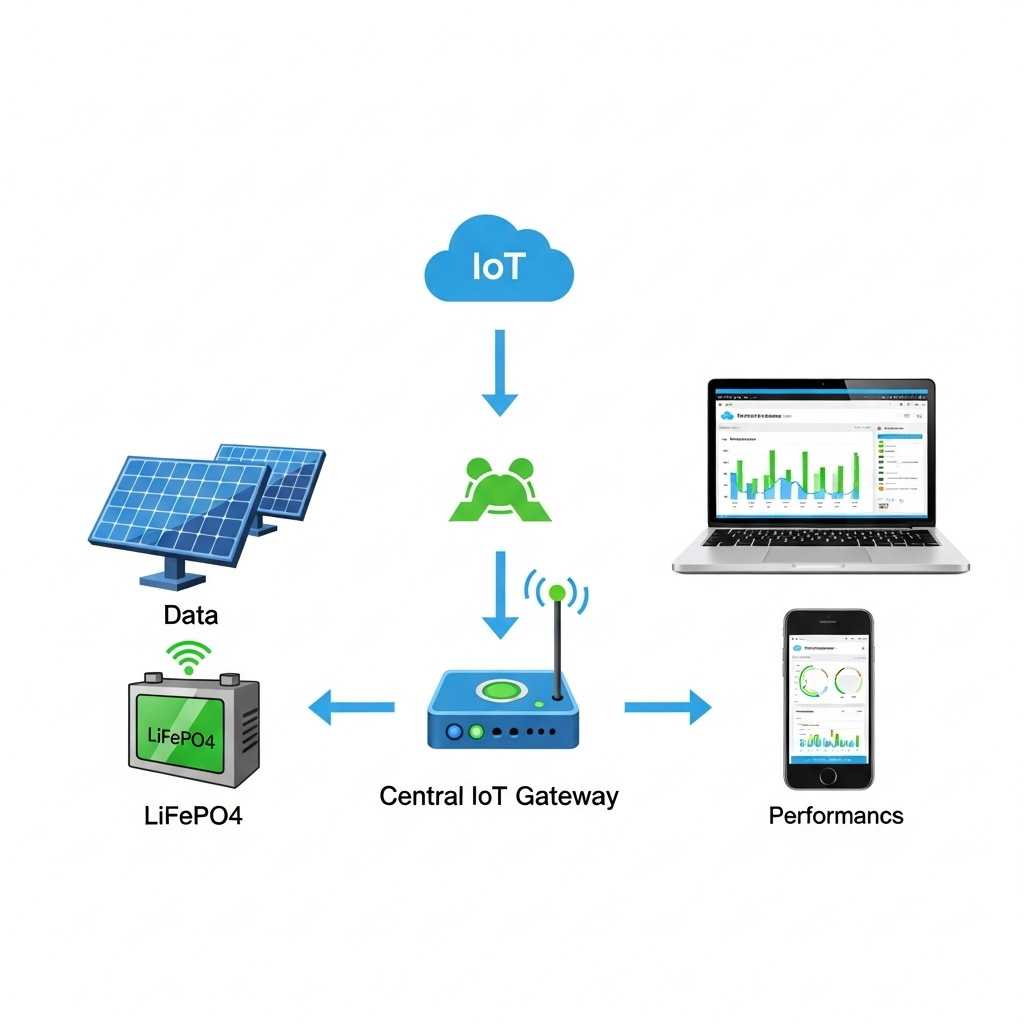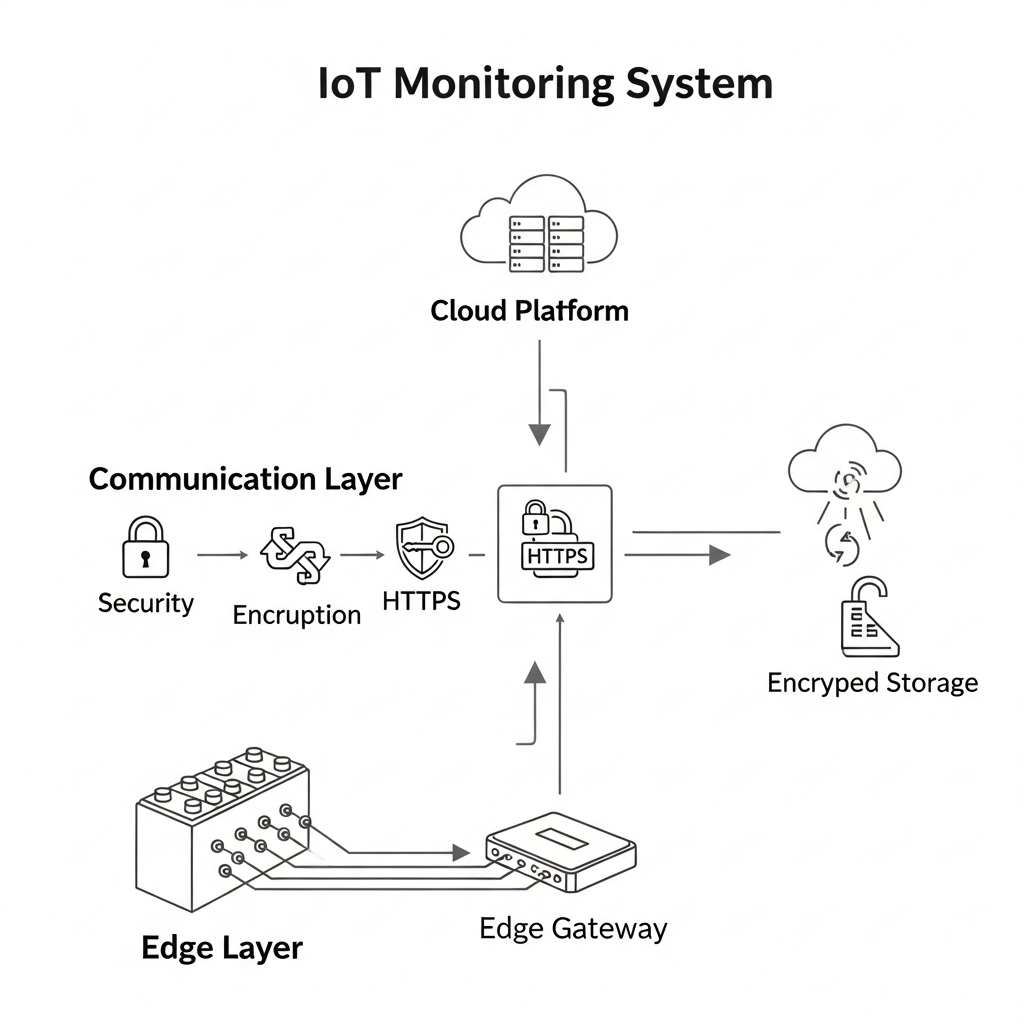As solar energy storage systems (ESS) become more widespread, managing them shifts from a simple task to a complex challenge. Monitoring a handful of sites is straightforward. Monitoring hundreds or thousands of distributed assets requires a different approach. A scalable IoT cloud monitoring solution is no longer a luxury; it is a strategic necessity for maintaining performance, ensuring reliability, and maximizing the return on investment across a large portfolio.
This guide provides a framework for understanding and implementing IoT cloud monitoring for solar ESS at scale. You will gain insights into the core architecture, essential platform features, and strategies to overcome common growth challenges. The goal is to equip you with the knowledge to build an efficient, data-driven asset management operation.
The Foundation of Scalable ESS Monitoring
A scalable monitoring system is built on a solid architectural foundation. This structure ensures that as your fleet of energy storage systems grows, your ability to manage it effectively grows as well. It involves a seamless flow of information from the individual asset to a centralized cloud environment.
From Edge Devices to the Cloud
The process begins at the 'edge'—the location of your solar ESS. Data loggers or IoT gateways are the workhorses here. They connect directly to the system's components, including the battery management system (BMS), the hybrid inverter, and any connected power meters. Their primary job is to collect a constant stream of data points, such as voltage, current, temperature, and state of charge. For this process to be scalable, data acquisition must be standardized. Using gateways that can communicate with hardware from various manufacturers prevents data silos from forming as your portfolio diversifies.
Secure and Efficient Data Transmission
Once collected, the data must be transmitted securely and efficiently to the cloud. For large fleets of devices, lightweight communication protocols are critical. MQTT (Message Queuing Telemetry Transport) is a common choice because it was designed for IoT applications. It uses minimal bandwidth, which is ideal for sending frequent updates from thousands of devices without overwhelming networks. Just as important is security. All data transmitted from the edge to the cloud should be encrypted using protocols like TLS (Transport Layer Security) to prevent unauthorized access and ensure data integrity.
Essential Capabilities for a Robust Cloud Platform for ESS
A powerful cloud platform does more than just store data. It transforms raw information into actionable intelligence that drives operational excellence. For large-scale portfolios, certain features are indispensable for effective management.
Centralized Fleet Management and Visualization
Managing assets at scale is impossible without a single pane of glass. A sophisticated cloud platform provides a centralized dashboard to visualize the health and performance of your entire fleet. Key features include a geographic map showing the real-time status of every system, hierarchical views that let you group assets by customer or region, and customizable widgets for at-a-glance performance metrics. This allows operators to quickly identify and prioritize issues across the portfolio instead of checking systems one by one.
Advanced Analytics and Performance Benchmarking
Raw data alone has limited value. A scalable IoT platform must include an analytics engine that processes data to reveal deeper insights. It should automatically calculate key performance indicators (KPIs) that are vital for understanding asset value. As detailed in the ultimate reference on solar storage performance, metrics like round-trip efficiency, depth of discharge, and battery state of health (SOH) are crucial for evaluating long-term viability. The platform should enable you to benchmark performance across similar systems to identify underperforming assets and best practices.
| Monitoring Metric | Basic Monitoring | Advanced Scalable Monitoring |
|---|---|---|
| System Status | Online / Offline | Detailed component status, communication latency |
| Energy Data | Daily Production / Consumption | 5-minute interval data, peak shaving analysis |
| Battery Health | State of Charge (SOC) | State of Health (SOH), cycle count, cell-level diagnostics |
| Performance | Current Power Output | Round-Trip Efficiency, degradation analysis, peer benchmarking |
| Alerts | System Fault | Predictive alerts for component failure, performance deviation alarms |
Proactive Alarms and Predictive Maintenance
A reactive approach to maintenance is inefficient and costly. A modern cloud platform uses rule-based and AI-driven alarms to enable proactive maintenance. Instead of waiting for a system to fail, the platform can alert you to conditions that predict a future failure. For example, an alarm could be triggered if a battery cell's voltage deviates significantly from others in the pack, or if an inverter's internal temperature consistently runs high. This allows you to schedule maintenance before a critical failure occurs, reducing downtime and operational costs. According to the IEA's report, System Integration of Renewables, the ability to collect and analyze operational data is fundamental, and insufficient monitoring capabilities can jeopardize the entire operation.
Overcoming Scalability Challenges
As your fleet expands, you will encounter new challenges related to data volume, integration, and system diversity. A truly scalable platform is designed to handle this growth seamlessly.
Handling Data Volume and Velocity
A fleet of a thousand energy storage systems can generate millions of data points every hour. This 'big data' problem can quickly overwhelm conventional databases and applications. A scalable cloud architecture is built to handle this. It often uses specialized time-series databases designed for high-speed ingestion and querying of timestamped data. Furthermore, modern cloud infrastructure relies on distributed microservices and serverless computing, allowing the platform to automatically scale its resources up or down based on demand. This ensures fast, responsive performance, whether you are managing ten systems or ten thousand. As noted in the IEA's analysis, China Power System Transformation, digital platforms that leverage cloud computing and big-data analytics are essential for optimizing a vast number of distributed energy assets collaboratively.
Ensuring Interoperability and Future-Proofing
Over time, your asset portfolio will likely include hardware from multiple manufacturers. A monitoring platform that only works with one brand of inverter or battery creates vendor lock-in, severely limiting your flexibility and growth potential. To avoid this, choose a cloud platform built on the principle of interoperability. This means it should support open standards, such as SunSpec for solar and storage device communication, and provide a robust Application Programming Interface (API). An open API is crucial for integrating the monitoring platform with other business software, such as CRMs, billing systems, or asset management tools, creating a unified and automated operational workflow. The IEA's Medium-Term Renewable Energy Market Report 2016 highlights the statistical challenges of tracking dispersed renewable assets, a problem that interoperable and standardized monitoring platforms are designed to solve.
Translating Technical Capabilities into Business Value
Ultimately, a scalable IoT monitoring platform must deliver a clear return on investment. Its technical features directly translate into financial benefits by improving efficiency and maximizing asset performance.
Reducing Operational and Maintenance (O&M) Costs
The most immediate benefit is a significant reduction in O&M expenses. With remote diagnostics, technicians can analyze issues from anywhere, often resolving them without a site visit. When a 'truck roll' is necessary, the technician arrives with a clear understanding of the problem and the right parts, improving the first-time fix rate. For a large fleet, this translates into substantial savings. For example, reducing unnecessary site visits by just 25% across a portfolio of 1,000 systems can save thousands of dollars annually in labor and travel costs.
Maximizing Asset Performance and Revenue
Effective monitoring ensures that every asset in your portfolio is generating its maximum possible value. By tracking performance against benchmarks, you can quickly identify and rectify issues like shading, soiling, or component degradation that hurt energy production. For battery systems, the platform's data can inform optimal charging and discharging strategies to maximize savings from time-of-use rates or participate in grid services programs. This data also serves as an indisputable record of performance, which is vital for validating warranty claims and satisfying the reporting requirements of project financiers.
Your Next Steps in Intelligent ESS Management
Building a scalable monitoring solution for solar ESS is a strategic imperative for any organization looking to grow its distributed energy portfolio. It is the key to transforming a collection of individual systems into a cohesive, optimized, and highly valuable fleet of assets. The core principles are clear: start with a foundation of standardized data acquisition, choose a cloud platform rich with features for fleet management and advanced analytics, and insist on an open, interoperable architecture to ensure future flexibility.
By embracing a data-driven approach, you can move beyond reactive problem-solving and unlock new levels of operational efficiency. This allows you to reduce costs, maximize performance, and confidently scale your solar and storage operations for long-term success.
Disclaimer: This article is for informational purposes only and does not constitute financial or investment advice. Consult with a qualified professional before making any investment decisions.
Frequently Asked Questions
What is the difference between SCADA and an IoT cloud platform for ESS?
Traditional SCADA (Supervisory Control and Data Acquisition) systems are typically designed for monitoring and controlling large, centralized power plants within a private network. An IoT cloud platform is built for managing a large number of geographically distributed, smaller assets like residential or commercial solar ESS. It uses public cloud infrastructure, is inherently more scalable, and often offers more advanced analytics and fleet management features accessible from anywhere.
How much data does a typical solar ESS generate?
A single residential solar ESS can generate between 10 to 50 megabytes of data per day, depending on the number of parameters being monitored and the data reporting frequency. When you scale this to a fleet of thousands of systems, the total data volume can easily reach several gigabytes per day. This is why a scalable cloud architecture designed for big data is so important.
Can I build my own IoT monitoring platform?
Building a proprietary IoT platform is a significant undertaking that requires expertise in embedded systems, network security, cloud architecture, big data, and application development. While possible, it is often more cost-effective and faster to leverage a specialized third-party IoT platform. This allows you to focus on your core business of deploying and managing energy assets rather than software development.
How does IoT monitoring contribute to the safety of solar energy storage systems?
IoT monitoring is a critical layer of safety. The platform continuously tracks key safety parameters from the Battery Management System (BMS), such as cell temperatures, voltages, and currents. It can issue immediate alerts if any parameter exceeds safe operating limits, allowing for a rapid response. This can help prevent thermal runaway and other hazardous events by identifying potential issues long before they become critical failures.





Leave a comment
All comments are moderated before being published.
This site is protected by hCaptcha and the hCaptcha Privacy Policy and Terms of Service apply.